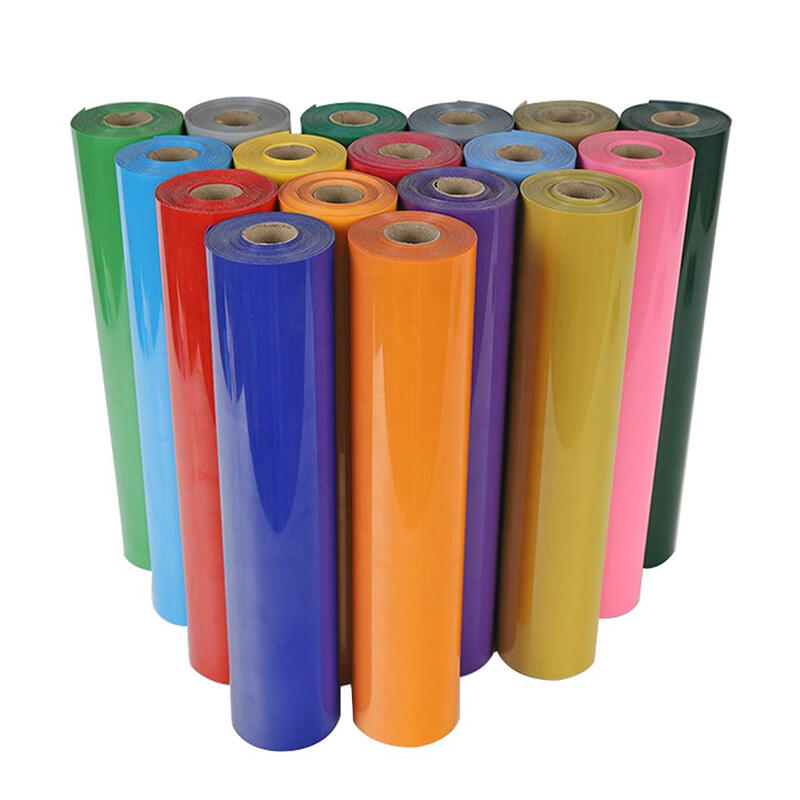Heat transfer vinyl has revolutionized the world of custom apparel and fabric decoration, offering endless possibilities for creative expression. However, even experienced crafters can fall into common pitfalls that compromise their projects. Understanding these mistakes and learning how to avoid them is crucial for achieving professional-quality results, especially when working with delicate fabrics like cotton canvas. From temperature mishaps to material selection errors, these oversights can turn an exciting creative project into a frustrating experience that wastes both time and materials.

Temperature and Pressure Control Issues
Incorrect Heat Settings
One of the most frequent mistakes crafters make involves using inappropriate temperature settings for their heat press or iron. Different vinyl types require specific temperature ranges, and exceeding these limits can cause the vinyl to burn, bubble, or fail to adhere properly. PVC heat transfer vinyl typically requires temperatures between 300-320°F, but this can vary based on the manufacturer and specific product line. Always consult the manufacturer's instructions and conduct test runs on sample materials before committing to your final project.
Temperature inconsistencies across the heat press surface can also create uneven adhesion. Regular calibration of your equipment ensures uniform heat distribution, preventing those frustrating patches where the vinyl lifts or appears dull. Consider investing in a temperature gun to verify actual surface temperatures, as the display readings on some heat presses can be inaccurate by significant margins.
Inadequate or Excessive Pressure
Pressure application requires careful balance to achieve optimal results. Too little pressure prevents proper bonding between the vinyl and fabric, leading to premature peeling and poor wash durability. Conversely, excessive pressure can damage delicate fabrics, create unwanted texture impressions, or cause the adhesive to ooze beyond the vinyl boundaries. The ideal pressure should be firm enough to ensure complete contact without crushing the fabric fibers.
When working with thicker materials like cotton canvas, slight pressure adjustments may be necessary to accommodate the fabric's density. Cotton canvas requires consistent, moderate pressure to ensure the vinyl bonds effectively with the textured surface without compromising the fabric's integrity. Test different pressure settings on fabric scraps to determine the optimal level for your specific project requirements.
Material Selection and Preparation Errors
Wrong Vinyl Type for Fabric
Selecting inappropriate vinyl types for specific fabric compositions represents a critical error that can doom projects from the start. PVC heat transfer vinyl works excellently on cotton, polyester, and cotton blends, but may not adhere properly to specialty fabrics like nylon, leather, or heavily textured materials. Understanding fabric composition and its compatibility with different vinyl types prevents adhesion failures and ensures long-lasting results.
Fabric weight and stretch characteristics also influence vinyl selection. Lightweight fabrics may require thinner vinyl films to maintain drape and flexibility, while heavier materials like cotton canvas can accommodate standard or even thicker vinyl without compromising comfort or appearance. Consider the end-use application when selecting materials, as garments requiring frequent washing need more durable vinyl formulations than decorative items.
Inadequate Surface Preparation
Proper fabric preparation significantly impacts vinyl adhesion quality and longevity. Many crafters skip the crucial pre-pressing step, which removes moisture, wrinkles, and fabric sizing that can interfere with bonding. Pre-pressing also allows you to identify any fabric imperfections or inconsistencies that might affect the final appearance. This step is particularly important for cotton canvas, which often contains natural oils and sizing materials that must be eliminated before vinyl application.
Fabric selection timing matters as well. Freshly washed fabrics may retain soap residues or fabric softeners that create barriers between the vinyl and fabric surface. Allow fabrics to cure for at least 24 hours after washing, and avoid using fabric softeners on materials intended for heat transfer vinyl applications. Clean, dry, and properly prepared surfaces ensure optimal adhesion and professional-looking results.
Design and Cutting Complications
Mirror Image Mistakes
Forgetting to mirror designs before cutting represents one of the most common and frustrating errors in heat transfer vinyl work. Since HTV is applied face-down during pressing, designs must be reversed during the cutting process to appear correctly when applied. This mistake becomes particularly problematic with text-based designs, logos, or directional graphics that lose meaning when accidentally reversed.
Develop systematic workflows that include mirror-checking as a standard step before cutting begins. Many cutting software programs include automatic mirroring functions for HTV projects, but manual verification prevents costly material waste. Create reminder systems or checklists to ensure this critical step never gets overlooked, especially when working on complex or time-sensitive projects.
Improper Cutting Settings
Cutting blade depth and pressure settings require careful adjustment for different vinyl types and thicknesses. Too shallow cuts leave vinyl partially attached to the carrier sheet, making weeding difficult and potentially damaging fine design elements. Conversely, cutting too deeply can damage the carrier sheet, create rough edges, or cause the cutting mat to wear prematurely.
Regular blade maintenance ensures consistent cutting quality and prevents common issues like dragging, tearing, or incomplete cuts. Replace cutting blades according to manufacturer recommendations and adjust settings based on vinyl thickness and complexity. Test cuts on small sections help determine optimal settings before committing to full designs, particularly when working with new vinyl types or intricate patterns.
Application Process Mistakes
Timing and Sequence Errors
Proper timing during the application process significantly affects final results. Rushing through the cooling period before removing the carrier sheet can cause vinyl to lift or distort, while waiting too long may make removal difficult and potentially damage delicate design elements. Most PVC heat transfer vinyls require specific cooling times that allow the adhesive to set properly while maintaining removability of the carrier material.
Multi-layer designs require careful sequencing to ensure proper adhesion between layers and the base fabric. Each layer needs adequate pressing time and temperature, and the order of application can affect both appearance and durability. Plan complex designs carefully, considering how multiple vinyl layers will interact and ensuring each component receives appropriate treatment for lasting results.
Incomplete Heat Distribution
Ensuring uniform heat distribution across entire designs prevents partial adhesion and premature failure. Large designs may require multiple pressing cycles with overlapping coverage to guarantee complete bonding. Edge areas and design corners often receive less heat and pressure, making them vulnerable to lifting and peeling over time.
When working with cotton canvas substrates, pay special attention to textured areas that may not make complete contact with the heat press. Use pressing cloths or Teflon sheets to protect vinyl surfaces while ensuring even heat transfer. Consider the fabric's thickness and density when determining pressing times, as denser materials may require longer heat exposure to achieve proper bonding temperatures throughout the fabric structure.
Post-Application Care Issues
Premature Handling
Handling projects immediately after pressing can compromise adhesion quality and cause design distortion. Heat transfer vinyl continues bonding with fabric fibers even after the initial pressing cycle, and premature manipulation can disrupt this process. Allow projects to cool completely and rest for at least 24 hours before washing or heavy use to ensure maximum bond strength.
Storage conditions during the curing period also influence final durability. Keep finished projects flat and avoid folding or creasing vinyl areas until the adhesive has fully set. Temperature and humidity fluctuations can affect curing times, so maintain stable environmental conditions when possible to ensure consistent results across different projects.
Inappropriate Washing Instructions
Providing incorrect care instructions to end users can lead to premature vinyl failure and customer dissatisfaction. PVC heat transfer vinyl requires specific washing conditions to maintain appearance and adhesion over time. Cold water washing, gentle cycles, and avoiding bleach or fabric softeners help preserve vinyl integrity and prevent premature deterioration.
Drying methods significantly impact vinyl longevity, with air drying generally providing better results than machine drying. When machine drying is necessary, low heat settings and removal while slightly damp help prevent excessive heat exposure that can cause vinyl to crack or peel. Educate customers about proper care techniques to ensure their investment in custom decorated items provides lasting satisfaction.
FAQ
What temperature should I use for PVC heat transfer vinyl on cotton canvas
For cotton canvas applications, set your heat press to 305-315°F with medium pressure for 10-15 seconds. The thicker, denser nature of cotton canvas may require slightly longer pressing times compared to regular cotton fabrics. Always perform test applications on fabric scraps to determine optimal settings for your specific combination of vinyl and canvas weight.
Why does my vinyl keep peeling off after washing
Vinyl peeling typically results from insufficient pressing time, incorrect temperature settings, or inadequate surface preparation. Ensure your fabric is clean and free from sizing or fabric softener residues. Use appropriate temperature and pressure settings for your specific vinyl type, and allow adequate cooling time before removing the carrier sheet. Poor-quality vinyl or expired materials can also contribute to adhesion failures.
Can I layer different types of heat transfer vinyl
Yes, but compatibility between vinyl types varies significantly. PVC vinyls generally layer well with other PVC products, but mixing PVC with polyurethane or specialty vinyls may cause adhesion problems. When layering, press each layer individually with appropriate settings, and allow complete cooling between applications. Test layering combinations on sample materials before committing to final projects.
How long should I wait before washing newly applied vinyl
Wait at least 24-48 hours after application before the first washing to allow the adhesive to fully cure and bond with the fabric fibers. This waiting period is particularly important for cotton canvas and other dense fabrics that may require additional time for complete adhesive penetration. Following this guideline significantly improves wash durability and overall vinyl longevity.

